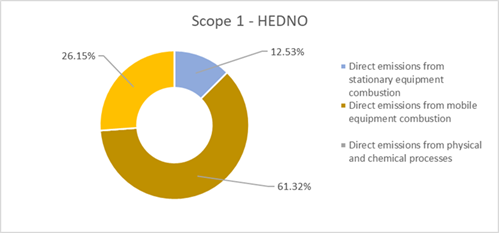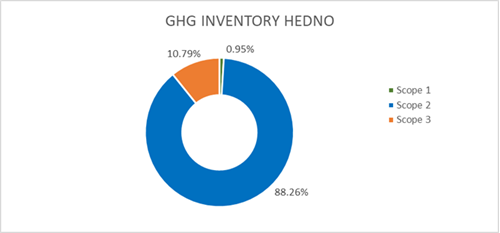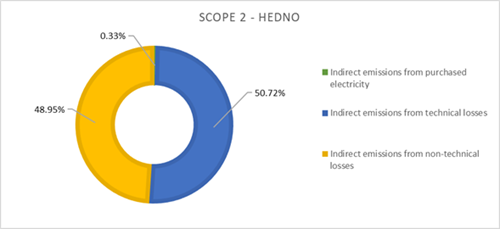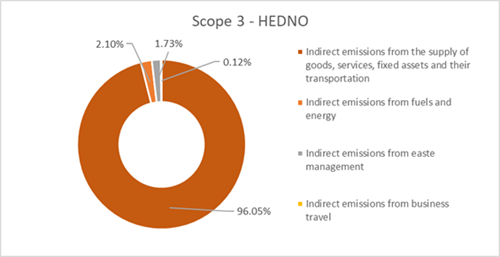Environment Indices (Ε)*
*Due to ISO 14064-1:2018 verification of HEDNO S.A.’s 2021 gas emission data, ESG ATHEX indices C-E1, C-E2 & A-E1 were modified accordingly. ESG ATHEX C-E3 indice was also modified accordingly.
The ISO 14064-1:2018 verification was completed within the year 2023 and therefore the values of the beforementioned indicators differ from those in the Group's 2021 Sustainable Development Report.
| C-E1 | Direct emissions: 15,632 t CO2 eq (Scope 1) | |||||||
| Direct emissions from stationary equipment combustion | 1,958 | 12.53% |
| Direct emissions from mobile equipment combustion | 9,586 | 61.32% |
| Direct fugitive emissions from greenhouse gases | 4,088 | 26.15% |
| TOTAL | 15,632 |
| FROM TOTAL (t CO2 eq): 1,648,960 |
||
| Scope 1 | 15,632 | 0.95% |
Another way to monitor environmental performance is by applying intensity indicators. The intensity of direct emissions (Scope 1) for 2021 is 16.52 t CO2 eq / € million.
| C-E2 | Indirect emissions from purchased energy: 1,455,403 t CO2 eq (Scope 2) | |||
| Indirect emissions from purchased electricity | 4,753 | 0.33% |
| Indirect emissions from technical losses | 738,210 | 50.72% |
| Indirect emissions from non-technical losses | 712,440 | 48.95% |
| TOTAL | 1,455,403 |
| FROM TOTAL (t CO2 eq): 1,648,960 | ||
| Scope 2 | 1,455,403 | 88.26% |
Another way to monitor environmental performance is by applying intensity indicators. The intensity of Indirect emissions (Scope 2) for 2021 is 1,538.07 t CO2 eq / € million.
| C-E3 | Energy consumption within the organization | ||||
| Total Energy consumption within the organization | 57,872 MWh |
| Percentage of electricity consumed (%) | 24.54 |
| Percentage of energy consumed from renewable sources (%) | 0 |
| Total energy generation (MWh) | 0 |
| Percentage of energy generated from renewable sources (%) | 0 |
| A-E1 | Other indirect emissions: 177,925 t CO2 eq (Scope 3) | |||
| Scope 3 (t CO2 eq) | ||
| Indirect emissions from the supply of goods, services, fixed assets and their transportation (Category 1 & 2) | 170,902 | 96.05% |
| Indirect emissions from fuels and energy (Category 3) | 3,730 | 2.10% |
| Indirect emissions from waste management (Category 5) | 3,082 | 1.73% |
| Indirect emissions from business travel (Category 6) | 211 | 0.12% |
| TOTAL | 177,925 | |
| FROM TOTAL (t CO2 eq): 1,648,960 |
||
| Scope 3 | 177,925 | 10.79% |
Another way to monitor environmental performance is by applying intensity indicators. The intensity of Other indirect emissions (Scope 3) for 2021 is 188.03 t CO2 eq / € million.
| A-E2 | Climate change risks and opportunities | |||
i. description of the risk or opportunity and classification as physical, regulatory or other
Any unforeseen event that exposes the company to obstacles to the implementation of its goals can be characterised as a risk. A risk that is inherent in climate change directly affects HEDNO’s operation and thus is classified as an operational risk. It should be noted that RAE has set some environmental criteria; lack of implementation may give rise to a regulatory risk. This risk is an opportunity to strengthen the network at a technical level with interventions that will not have an impact on the soil surface, fauna and flora.
ii. description of the impact related to the risk or opportunity
HEDNO must assess the bidirectional impact of these risks and take measures to increase its resilience, so as to reduce the possibility of negative impact on the operation as well as any impact on society as a whole to acceptable levels. It will thus implement national and international compliance rules.
iii. the financial impact of the risk or opportunity before any action is taken
The financial impact relates to both the financial result of the company and the living conditions of the affected social groups.
iv. the methods used to manage the risk or opportunity
Currently, risk management is performed with ad hoc methods, at a decentralised level. The Enterprise Risk Management system is a newly established HEDNO branch, estimated to be implemented and activated by the end of 2022.
v. the cost of actions taken to manage the risk or opportunity
Forecasts and remedial actions are made at a decentralised level and there is no single calculation formula. The Enterprise Risk Management system is a newly established HEDNO branch, estimated to be implemented and activated by the end of 2022.
HEDNO establishes a holistic risk management framework for their identification and mitigation. It combines superior management under the supervision of the BoD and a clear assignment of roles and responsibilities with a clear distinction between management, control and assurance of operation.
Climate risks
Α. Transition risks
| Policy and legal risks - policy actions |
Risk of dependence on energy imports if energy security is not ensured in a way that is compatible with the ambitious EU agenda on climate neutrality and national climate objectives. Risk of ambiguities and gray areas in the legislative/regulatory framework regarding responsibilities and competencies (the framework should be revised and barriers such as authorisation procedures should be removed). Risk of inability to invest if there is no appropriate support mechanism providing financial tools and incentives. Risk of failure to achieve the national objectives in the absence of multilateral cooperation and public-private partnerships. Legal risks - need to insure assets against climate risks. |
| Technology risks - technological progress or innovations | HEDNO should monitor the modern developments in the technologies and methods developed, utilise the emerging technological trends in the energy map (clean energy technologies, RES, smart grids-microgrids, eMobility, storage solutions, hydrogen dynamics, energy communities, etc.) and adapt to the emerging challenges that their application entails (e.g. RES penetration into saturated networks, equipment required to increase remote surveillance via telemetry, address cybersecurity threats due to network digitalisation etc.) |
| Market risks – shifts in supply and demand |
Energy demand is directly dependent on the climate of every region and climate change will have a significant impact on overall demand. With the increase in the penetration of variable RES (mainly wind and PV stations), the variability and uncertainty of the remaining load (load minus production from variable RES) and, consequently, the flexibility needs of the systems are increased, highlighting a significant challenge that the electricity system is called to face during the transition to green forms of energy. Faults in electrical networks can in turn cause multiple or systemic risks, such as cascading effects on other critical infrastructures at the national level due to the interconnection and interdependence between them, affecting the market. |
| Reputational risks - changing customer perceptions | HEDNO is invited to play a leading role in the shift towards sustainability by facilitating the design of green networks (harmonising its strategy based on the National Energy and Climate Plan) and to establish a profile of an Operator that supports the transition to a low-carbon economy. On the other hand, in order to make investments, their acceptance by local communities should be ensured. |
Β. Physical risks
| Acute risks – increased severity of extreme weather events |
Extreme weather events (shocks), such as:
|
| Chronic risks | Risks with long-term effects (stresses) • Drought • Humidity • Movement of geological formations (landslide / subsidence / deposition / liquefaction). The risks of this category are related catastrophic phenomena as a result of extreme weather events. • Sea level rise • Land erosion by the sea |
OPPORTUNITIES
• Upgrade the quality of services provided to network users (consumers) ensuring that power outages occur with less frequency and duration
• Modernisation of the distribution network infrastructure (more durable materials, improved equipment specifications, maintenance practices etc.)
• Utilisation of innovative technologies (IoT, robotics etc.)
• Sustainable development promotion though the promotion of green technologies (RES - storage solutions-eMobility)
• Energy transition of Non-Interconnected Islands (NII)
• Decentralised control - remote management due to the automation / digitisation of networks (smart grids)
• More efficient supply-demand management
• Development / utilisation of tools to support strategic decision-making
• Awareness raising and establishment of a prevention culture in the field of disaster and crisis management
• Holistic approach with resilience and protection of critical national infrastructures through coordination and partnerships between public and private bodies (HEDNO, IPTO, RAE, State, scientific personnel, critical infrastructure operators, insurance companies etc.)
| A-E3 | Waste management | |||
|
Quantity (t) | Waste percentage per type of treatment, in percentage (%). | ||
| By recovery activities (R) Percentage % |
By disposal activities (D) Percentage % |
|||
| Total quantity of waste to be treated | 12,174.030 | 100 | 0.00 | |
| Total quantity of hazardous waste to be treated | 404.150 | 100 | 0.00 | |
| Total quantity of non-hazardous waste to be treated | 11,769.880 | 100 | 0.00 | |
| A-E4 | Effluent discharge | |||
No hazardous wastewater are produced by HEDNO’s activities.
| A-E5 | Biodiversity-sensitive areas | |||
The activities of HEDNO include HV/MV and MV/LV Substations and LV, MV, HV Electricity Distribution Network that operate in accordance with the regulatory provisions derived from Greek and European Legislation.
HEDNO gives Information on specific operational areas of HV/MV Subs regarding their position in relation to the protected areas and the characteristics of the protected areas (see diagrams below). It is also reported that they own 54.664 hectares of land within Natura 2000 Special Protection Areas (SPA), Sites of Community Importance (SCI) and SPA - SCI protected areas and 78.242 hectares within other areas of high biodiversity value. The performance of HEDNO in terms of total 245 HV/MV Subs that HEDNO is responsible:
35 operational Subs are located in areas of high biodiversity value of which only 20 are within areas of the NATURA 2000 network and 11 within of other protected areas such as Wildlife Refuges and National Parks. 4 operational sites contain a small part of a high biodiversity value area and 6 are close to the boundary and outside high biodiversity value areas.
HV/MV Subs are located far and at a safe distance from priority Habitats of Annex I of Directive 92/43/EEC on the conservation of natural habitats and of wild fauna and flora.
There are no substations installed in Ramsar Convention on Wetlands or UNESCO World Heritage sites.
By properly monitoring and managing all activities that take place in areas of high biodiversity value, HEDNO mitigates the risks of negative impacts on biodiversity from Substations and Electricity Distribution Network.
In general, in the areas in which it operates for the distribution of electricity, the prevention of the loss of biodiversity and the protection and prevention of endangered species is an integral part of DEDDIE's environmental strategy.
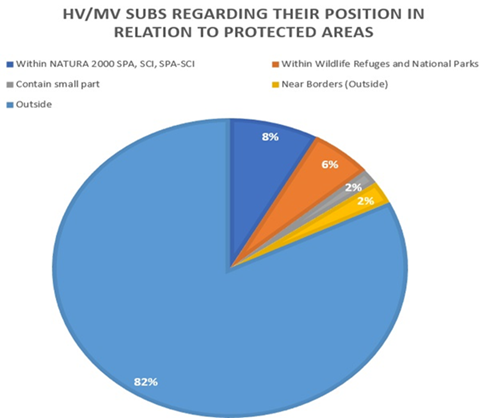 |
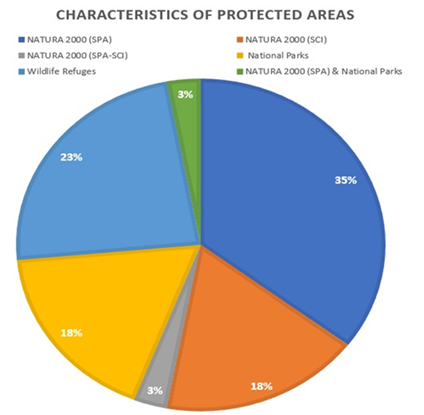 |
| SS-E1 | Emission management strategy | |||
The following actions have been set to shape the environmental policy with the aim of reducing the produced emissions:
1. Redesign and upgrade of the overhead MV distribution networks, replacing for example the transformers with new ones of higher efficiency, reducing thus the direct fugitive emissions from the release of greenhouse gases (technical and non-technical losses),
2. Use of an electric fleet to promote the use of eMobility, by adding to the fleet 90 hybrid and 230 electric vehicles and building charging stations in the territory,
3. Implementation and establishment of remote surveillance via telemetry (smart meters), contributing to energy saving, detection of faults and network malfunctions,
4. Energy upgrade of buildings housing HEDNO’s departments (for example and on a case-by-case basis: LED lighting, heat pump, electric vehicle charging system, Building Management System - BMS etc.).
| SS-E2 | Air pollutant emissions | ||
There are no gas emissions from the company’s activity.
| SS-E6 | Cancellations and backlogs | |||
There are no cancellations and backlogs officially recorded in a structured data record system of HEDNO.
| SS-E7 | Critical raw materials | |||
There are 27 critical raw materials recognised by the European Commission which are the following:
HEDNO S.A. does not handle or procure raw materials that are included in the above list.

